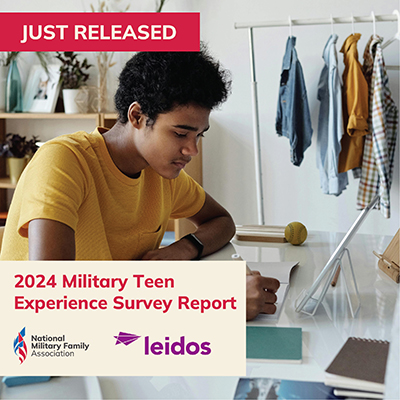Through Their Eyes: 2024 Military Teen Experience Survey Results

Since 2021, NMFA has surveyed military-connected teens to better understand their experience. Now in its fourth year, the 2024 Military Teen Experience Survey (MTES) is released in partnership with Leidos.
Thousands of military teens have participated each year, shining light on critical issues such as mental health, food insecurity, employment today, and their outlook on future military service. The 2024 results offer a powerful window into the lives of military teens, revealing both the immense challenges they face and the ways they try to overcome them.
Mental Well-Being
Military life is undeniably tough, and the weight of this lifestyle often takes a toll on teens. The 2024 MTES reveals that only 8% of military teens report high mental well-being, while a staggering 35% are struggling with low well-being. These numbers are much higher than those seen in civilian teens who, in a population study, largely reported a moderate well-being (75%) with the remaining quarter of respondents falling evenly into high and low categories.
For military teens, the scales are more imbalanced. With more than 3 in 10 military teens struggling with low mental well-being, this year’s MTES paints a picture of adolescents under tremendous emotional strain.
Worse still, military teens with a parent suffering from visible or invisible injuries, such as PTSD, are more than ten times as likely to report low mental well-being. These teens are not only grappling with typical adolescent pressures but also navigating the emotional toll and extra responsibilities that so often come with the care of a wounded, ill, or injured parent.
Despite their struggles, there’s good news: most military teens are getting the mental health care they think they need. But alarmingly, more than one in ten respondents (13%) identified that they needed help — but they couldn’t access it. Whether because their parents didn’t know how to get help, couldn’t get it, or the teens didn’t feel comfortable asking, this lack of support is a clear call to action for the adults in their communities: Our kids need help, and it’s up to us to make sure that military-connected youth need more accessible and proactive mental health resources to help them thrive.
Self-Harm
The MTES has uncovered an alarming trend in self-harm behavior among military teens. Shockingly, nearly half of respondents (45%) reported engaging in self-harm at least once, with one in three repeating the behavior multiple times in the past six months. These rates far exceed the global average of 18% for adolescents and point to a group of teens in deep distress.
Making sense of these numbers is tough for us to do, both as researchers and as adults responsible to the kids in our military community. Self-harm is often a desperate cry for help—an attempt to externalize the emotional pain they feel from the instability in their lives. Teens from food-insecure households, in particular, are more likely to engage in self-harm, illustrating the profound impact of financial stress on their mental health.
Self-harm isn’t always tied to suicidal intent, though it does serve as a maladaptive coping mechanism for dealing with emotional pain. Still, the higher rates of self-harm among military teens highlight an urgent need for targeted mental health interventions, support systems, and coping strategies that address the unique challenges these teens face.
The self-harm data also puts a new onus on those of us in the community with military teens. Not only do we have to pay attention and respond to self-harming military teens’ need for support, but we need to do more to understand their experience. Our 2025 Military Teen Experience Survey will look more closely at the experiences of these teens, the patterns of their behavior, and their engagement with resources to help.
Food Insecurity
Food insecurity is a quiet crisis for military teens, and the 2024 MTES shines a glaring spotlight on this growing problem. More than half (54%) of military teens surveyed reported experiencing low or very low food security in the past month. This figure far exceeds the 17.3% national average for households with children and even the reported 25% of military families who are food insecure.
Certain groups are hit harder than others: Teens from enlisted or junior-ranked families, those with parents suffering from service-related injuries, and those in households with multiple deployments are more likely to face food insecurity. For these families, financial strain often maintains a constant presence, having a direct impact on the teen’s well-being. The MTES found that teens from food-insecure households are 17.1 times more likely to report low mental well-being. The emotional burden of not knowing when or where their next meal will come from adds an extra layer of stress to their already challenging lives.
The issue of food insecurity is not just about hunger—it’s about the ripple effect it has on every aspect of a teen’s life. The stress and anxiety it causes often worsen mental health struggles, leading to a dangerous cycle of emotional and physical hardship. Addressing food insecurity in military families is essential for improving the well-being of military teens.
Teen Employment
Faced with financial pressures, many military teens are stepping up to contribute to their families’ income. In 2024, nearly one in five teens (19%) reported working to help support their family’s finances, while the majority (58%) worked for personal spending money. For many teens, employment is a necessary way to gain financial independence and ease the burden on their families.
However, balancing school, work, and family responsibilities is no easy feat, especially for military teens who are often uprooted due to relocations. The constant need to adjust to new schools, new communities, and new jobs adds to the already challenging life of a military teen.
Propensity to Serve
For many military teens, service is a family legacy, and the 2024 MTES shows that more than half (51%) of respondents plan to follow in their parent’s footsteps by joining the military, and 7% of respondents are already serving. This rate is far higher than that of their civilian peers, only ~10% of whom are planning to serve in uniform, according to DoD research. The sense of duty runs deep for many military teens, particularly those from active-duty families or families where a parent has been visibly injured, who are all the most inclined to join the military.
For these teens, military service represents more than just a job—it’s a way to honor their family’s sacrifices and continue a tradition of service. Many teens plan to serve after completing college, with some aspiring to join through ROTC, military academies, or officer training programs. But the decision to serve isn’t universal; some teens cite different career interests or a dislike of the military lifestyle as reasons for their plans to not join the military.
The 2024 Military Teen Experience Survey offers a compelling and often sobering view of the unique challenges faced by military-connected teens. From the toll of mental health struggles and self-harm to the stress of food insecurity and the pressure to contribute financially, these teens face a range of obstacles that set them apart from their civilian peers. Yet, they remain fueled by a strong sense of duty and determination to carry on their family’s legacy of service.
As NMFA continues to learn from military teens in our programs like Bloom: Empowering the Military Teen and throughout our community, we do so committed to serving and supporting their growth.





